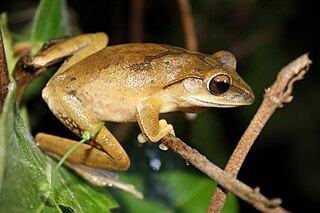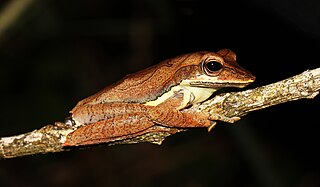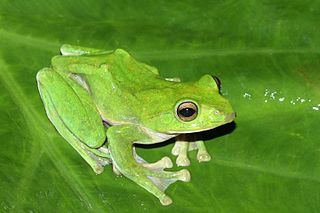
Polypedates is a genus of frogs in the family Rhacophoridae, the shrub frogs and Paleotropic tree frogs. They belong to subfamily Rhacophorinae. Members of this genus are collectively known as whipping frogs. They occur in eastern and southern Asia.

Polypedates maculatus, the Indian tree frog, or Chunam tree frog, is a common species of tree frog found in South Asia. It was described by John Edward Gray in 1830.

Polypedates megacephalus, the Hong Kong whipping frog or spot-legged tree frog, is a species in the shrub frog family (Rhacophoridae). In its native range, it is also called "brown tree frog", but this name is otherwise applied to a species of the true tree frog family (Hylidae).

Philautus hosii is a species of frog in the family Rhacophoridae. It is endemic to Borneo and has been found at 1,351 m (4,432 ft) above sea level. The specific name of the synonym, Polypedates chlorophthalmus, refers to its "remarkable green iris", from the Greek for "green-eyed". Accordingly, the common name green-eyed tree frog has been coined for the species.

Polypedates colletti is a species of frog in the family Rhacophoridae. It is found in the Malay Peninsula, southern Vietnam, Borneo, Sumatra, and islands of the South China Sea.

Polypedates cruciger is a species of frog in the family Rhacophoridae endemic to Sri Lanka.

Taruga fastigo is a species of frogs in the family Rhacophoridae. It is endemic to Sri Lanka and only known from its type locality, Morningside Estate near Rakwana. Prior to its description in 2001, it was confused with Polypedates eques.
Polypedates insularis is a species of frogs in the family Rhacophoridae. It is endemic to Great Nicobar Island, India.

Polypedates leucomystax is a species in the shrub frog family Rhacophoridae. It is known under numerous common names, including common tree frog, four-lined tree frog, golden tree frog or striped tree frog. Many past authors have united it with the common Indian tree frog in P. maculatus, but today they are generally considered distinct species. In its native range, it is also called "white-lipped tree frog", but this name is otherwise applied to a species of true tree frogs.

Polypedates macrotis, commonly known as the dark-eared treefrog, sometimes also Bongao tree frog, Bongao bubble-nest frog, Baram whipping frog, or brown-striped tree frog, is a species of frog in the family Rhacophoridae. It is found in the central peninsular Thailand, Sumatra, Borneo, and Sulu Archipelago as well as a range of other Philippine islands.
Polypedates mutus is a species of frog in the family Rhacophoridae. It is found in southern and southwestern China, Myanmar, Laos, Thailand, and Vietnam. However, it may actually represent two different species. It is not known which one of these is the "true" Polypedates mutus as specimens from the type locality in northern Myanmar have not been analysed. Its natural habitats are forests and the surrounding areas. It breeds in standing water. It is suffering from habitat loss.

Polypedates otilophus is a species of frog in the family Rhacophoridae. It is endemic to Borneo where it is widespread and found in Brunei, Indonesia, and Malaysia, typically in the lowlands but sometimes as high as 1,100 m (3,600 ft) above sea level. This species has prominent, sharp ridges behind the eye, above the ear, referred to in its names.

Polypedates pseudocruciger is a species of frog in the family Rhacophoridae endemic to the southern Western Ghats, India. It is a common and widespread frog. It is an arboreal edge habitat species generally associated with the understorey of tropical, moist evergreen forest. It breeds in small temporary ponds. Eggs are laid on a leaf over the pond.
Polypedates taeniatus is a species of frog in the family Rhacophoridae. It is found in the Bengal region of Bangladesh and India as well as in Assam and southern Nepal. It is also known as the Bengal whipping frog, Bengal whipping tree frog, and Terai tree frog.
Polypedates zed is a species of frog in the family Rhacophoridae. It is found in Nepal and possibly India. Its natural habitats are subtropical or tropical moist lowland forests, swamps, and freshwater marshes.

Zhangixalus smaragdinus is a species of frog in the family Rhacophoridae found in southwestern China, north-eastern India, Nepal, western Thailand, and northern Vietnam, and possibly in Bangladesh.
Polypedates subansiriensis is a species of frogs in the family Rhacophoridae. It is endemic to Northeast India and only known from its type locality, Soro village in the eponymous Lower Subansiri District, Arunachal Pradesh state. It is sometimes known as the Subansiri's tree frog or Subansiri tree frog.
Binsuluk Forest Reserve is a protected forest reserve on the Klias Peninsula, in Beaufort District of Interior Division, Sabah, Malaysia. It was designated as a Class 1 Protection Forest by the Sabah Forestry Department in 1992. Its area is 12,106 hectares (121.06 km2). The reserve is mostly flat, consisting mostly of peat swamp forest, with a small area of mangroves. The peat forests within this reserve, along with those in the nearby Klias Forest Reserve, are the last peat forests in Sabah.

Polypedates bengalensis, the brown blotched Bengal tree frog, is a species of frog in the family Rhacophoridae. It is endemic to West Bengal, India.













